Chart of the Week: 97% of consumers have abandoned a purchase because the service wasn’t convenient enough, showing that e-commerce needs to compete on more than price.
Convenience is the backbone of e-commerce and a huge reason that online shopping has boomed over the last few years. Shopping online offers the convenience of purchasing items when and where it suits you, via a payment method of your choice while also having your item delivered via a method that suits you.
It’s no wonder then that convenience is changing the way people shop and how they view certain shopping options, as the National Retail Federation’s latest research shows. This is why e-commerce brands need to consider more than the quality and price of the products they are offering when it comes to showcasing their proposition.
Inconvenience causes cart abandonment
When it comes to the most important things to consumers when online shopping, quality (32%) and price (30%) are the biggest influencing factors, with only 13% saying that convenience is important. However, this isn’t reflected in overall shopping habits, as 97% of consumers say they have backed out of making a purchase because of inconvenience.
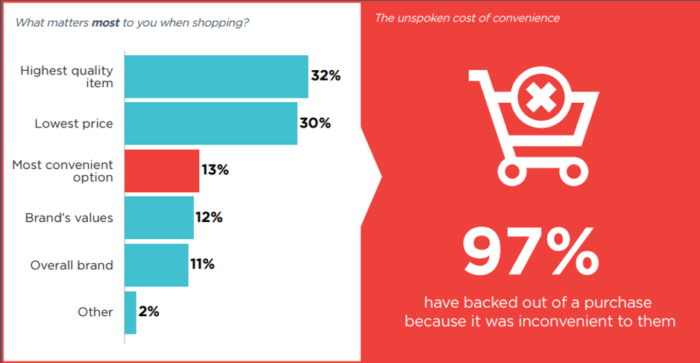
This means that while convenience may not be a big part of the initial purchase decision if the process of checking out and actually getting the product isn’t convenient, it will likely result in an abandoned cart.
Brands should, therefore, ensure that their online shopping experience is customer-focused and that they are offering the convenient options that customers want – such as next day delivery, guest checkout or store pickup – in order to ensure that consumers convert.
Convenience is more important than ever
With so much choice online and on the high street, consumers are looking for something that will really set brands apart. Convenience could be the key with 83% of consumers saying that convenience when shopping is more important now than it was five years ago.
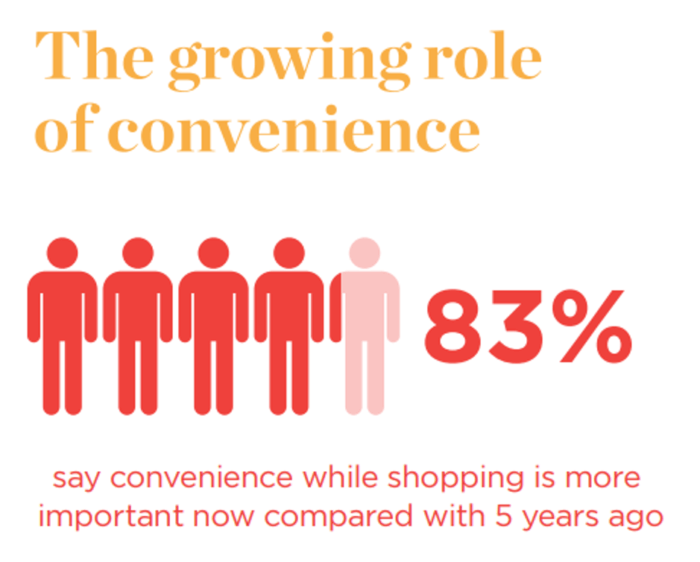
When you consider the fact that more than a third of consumers say they are busier now than they were five years ago, this is hardly surprising. Between commuting, work, school, and family, shopping needs to be done when it can be – which often means on the go. As a result, shoppers are on the lookout for retailers that can save them time.
Convenience influences purchases
Although consumers said that price and quality were the most important factors when making a purchase, 52% said that half or more of their purchases are influenced by convenience. Shoppers can no longer afford to spend hours picking up their groceries or a day looking for an outfit. Being time-poor means that convenience is now king.

This means that consumers are more willing than ever to pay for the luxury of convenience, with a spike in the popularity of delivery services like Amazon Prime. Currently, 66% of consumers pay for a delivery service, with 25% paying for more than one, showing that offering the idea of convenience can pay off for retailers.
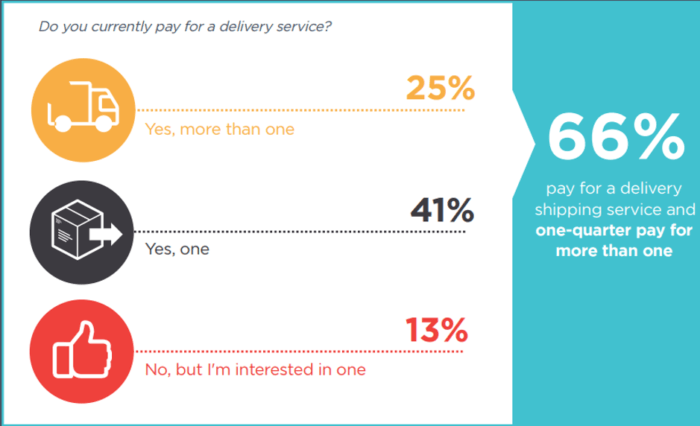
Convenience is vital in certain retail industries
While offering convenience across e-commerce is important, it is even more important within certain industries. Purchases that people make on a more regular business – such as groceries and personal care – need to offer a greater level of convenience in order to be worthwhile. However, convenience is still appreciated for other purchases, with consumers happy to pay for that convenience.
Some 63% say that convenience is very important when it comes to grocery shopping, with 66% saying they are willing to pay more to ensure their purchase is more convenient. This can be anything from choosing a delivery or pick-up time to getting an update of what items are unavailable or have been substituted.
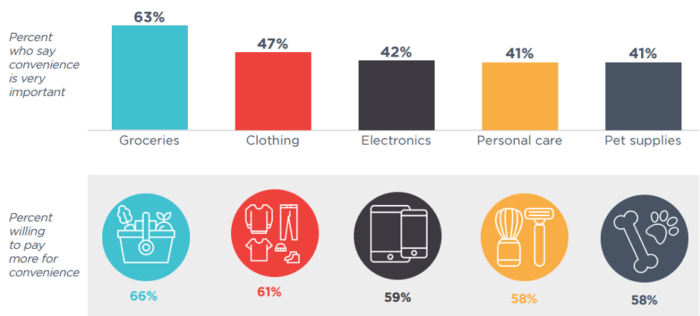
Clothing is the next type of purchase where convenience is seen as important, with 47% of consumers stating this and 61% happy to pay for a convenient experience. Options like online sizing, varying delivery options, and free returns all help to produce the best possible experience and could result in customers becoming brand advocates.
Other types of purchases where convenience is seen as important are electronics (42%), personal care (41%) and pet supplies (41%), with 59% 58% and 58%, respectively, saying they will pay for more convenient services when making these purchases.

Different types of convenience
Of course, convenience isn’t a one-size-fits-all thing. Each customer will have a different idea of what constitutes convenience with this relying on what they’re buying, how they’re shopping, where they are in the purchase journey and personal preference.
One big option when it comes to convenience is the ability to buy online and pick up in-store (BOPIS). The majority (70%) of consumers agree that this option has improved their shopping experience.
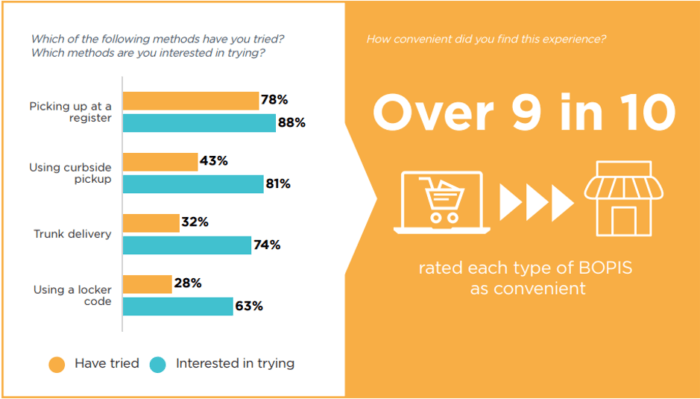
In terms of different BOPIS options, the most popular is picking an item ordered online up at the register of a brick and mortar shop, with 78% saying they have tried this option and 88% of those who haven’t tried this saying they are interested in doing so.
Although options like this improve the convenience you offer, you need to consider options across the path to purchase, ensuring that any possible pain points are dealt with. It’s also important to remember that the path to purchase – and therefore where people want convenience – changes whether people are shopping online or in-store.
When it comes to buying online, 38% of consumers say that convenience is important right at the start of their purchase as it makes researching products easier. Some 20% believe its important right before making their purchase while 18% want it at the checkout and 23% want it after they have made their purchase.
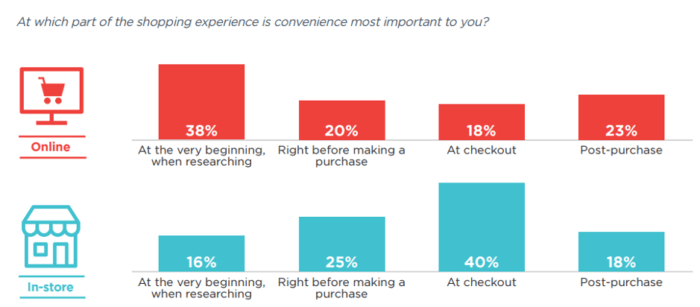
In comparison, most people (40%) shopping in-store want convenience at the checkout. Only 16% want it right at the start, 25% before making their purchase and 18% after making their purchase. This shows that online and offline shopping habits and requirements are very different.
How are brands performing?
So far it seems as though brands have been performing well in terms of delivering the convenience required by customers, with 86% of consumers saying shopping is now more convenient than it was five years ago. On top of this, just 36% say that retailers don’t live up to their convenience expectations, so although there is still work to be done, the results so far are positive.
This expectation of convenience now means that more than nine out of ten consumers are more likely to choose a retailer based on the convenience it offers. A third (33%) are significantly more likely to do so, showing that talking about convenient options throughout the customer journey is key.
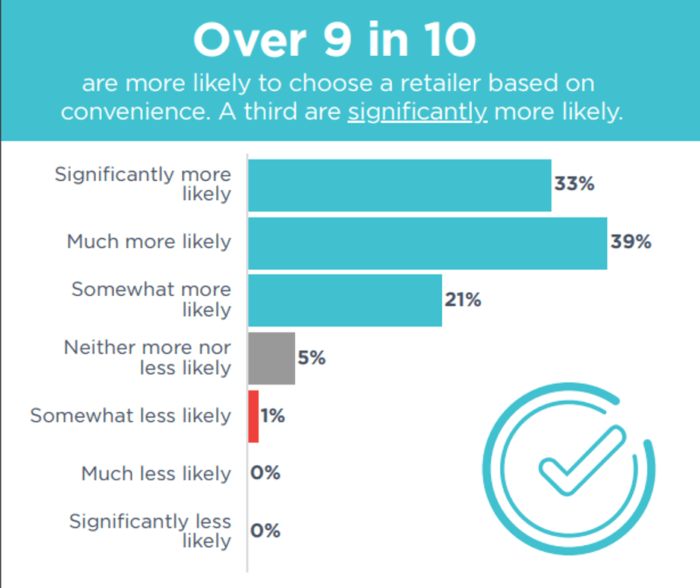
How can brands offer more convenience?
Although shopping is now more convenient, consumers still want more that makes purchasing products easier and more time-efficient.
When shopping online, the extra levels of convenience are at the research stage, with 58% wanting it to be easier to find deals and promotions, 57% comparing prices or reviews and 56% wanting it to be easy to find options.
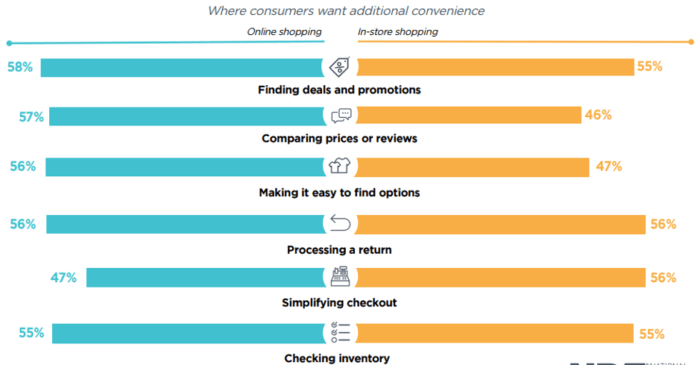
Comparatively, those shopping in-store want a simplified checkout (56%), easier returns (56%) and inventory checking (55%), although 55% also want it to be easier to find deals and promotions showing that price is still a factor.
Download our Free Resource – E-commerce personalization buyer’s guide
Learn everything you need to about e-commerce personalization before taking the steps needed to start implementing it in your own company.
Access the
Final thoughts
Convenience is all part of the customer experience and should always be at the forefront of strategies and plans for your retail brand – both online and in-store. In a world where time is short and there are so many options available, it takes more than price to beat competitors so it’s vital that you look at how you can make shopping with your brand as easy and convenient as possible.
However, this doesn’t mean that you can simply emulate what your competitors are doing. You need to fully understand your customers and your target audience in order to provide the solutions that they want. Customer research can help you assess what options will improve your service, the shopping experience and the overall level of convenience you offer.

















